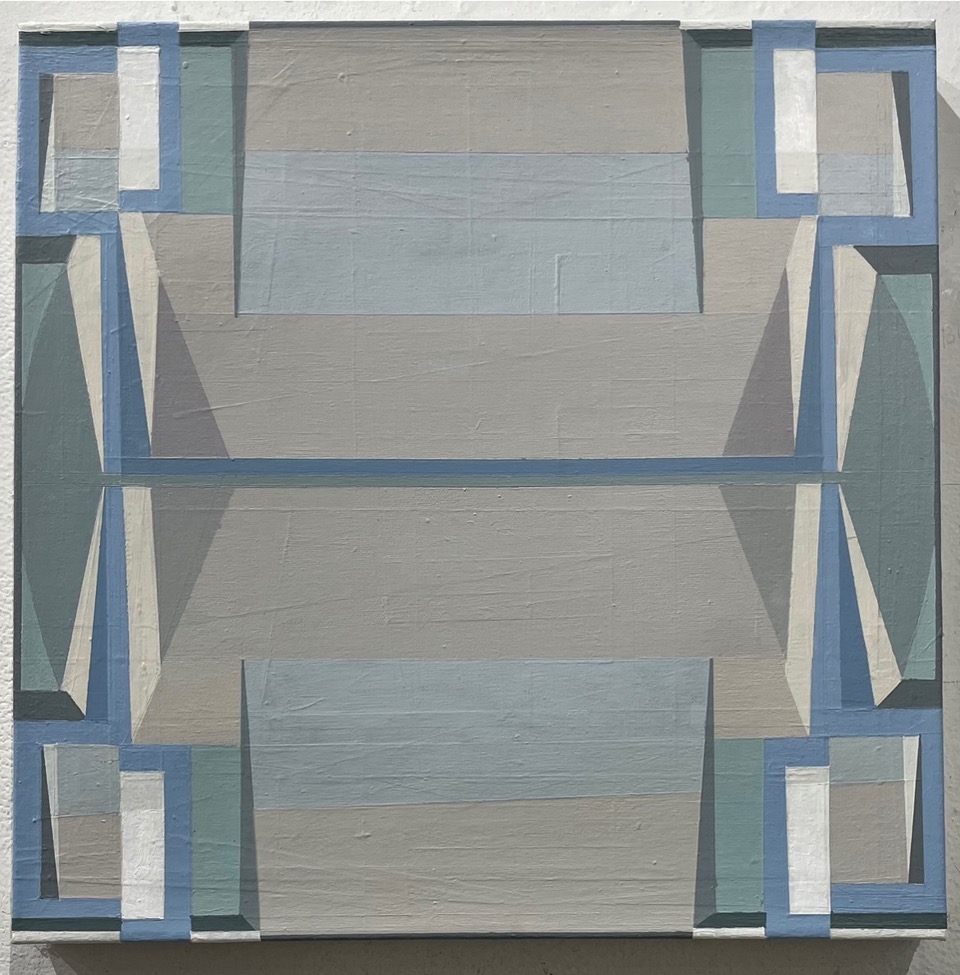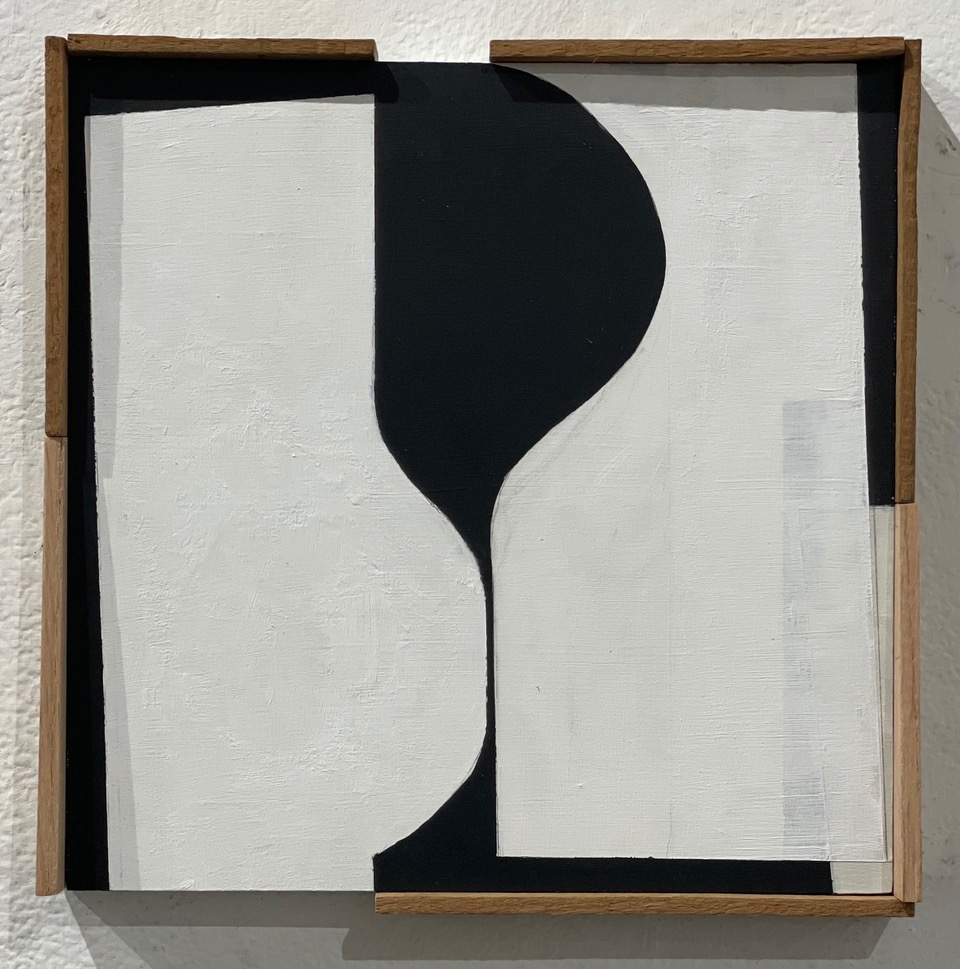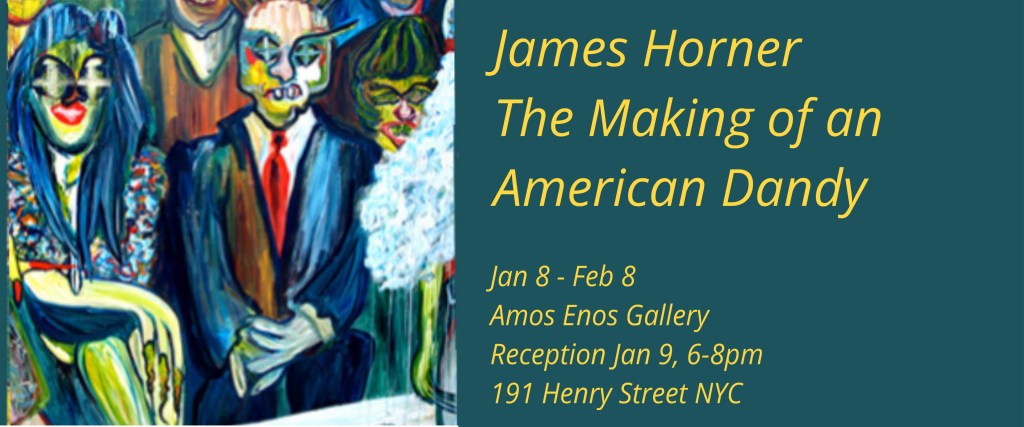
Contributed by Adam Simon / With a solo show at Rosebud Contemporary, work on view at Slag, and an upcoming two-person show at 490 Atlantic, Larry Greenberg is having a moment. After stepping away from the art world to raise a family, now, at the age of 73, he’s back. We talked about why, after a decades-long hiatus, he returned.
Adam Simon: You and I go back to probably our first day at the New York Studio School. I was 17 and you were 19. Everyone else was older because the school was unaccredited. What brought you there?
Larry Greenberg: When I was 15 until I was about 18 I was given the opportunity to work in the studio of painter Harold Baumbach (the filmmaker Noah Baumbach’s grandfather, by the way). It was kind of an of old-school apprenticeship. He told me I should go to the Studio School.
AS: Wasn’t he the artist that the Dustin Hoffman character was based on in the film The Meyerowitz Stories?
LG: Yes, he was — he was irascible but not quite as bad as depicted in the movie. Somehow, we really got along.
AS: I love that movie for the fact that it depicts an older, bitter, disappointed artist. It’s not something you get to see much in movies. The way that artists are represented in popular culture and how it has evolved could be the basis for an interesting study. Lately, I’ve been noticing artists depicted as pretentious poseurs in a lot of mainstream movies and TV series. An exception to this trend was Kelly Reichardt’s Showing Up. Did you see it?
LG: Harold was for real. Even as a teenager I felt he was a lesson for me in what not to become. That said, he was totally devoted to his work, which I admired. I did watch Showing Up. I had trouble identifying with the characters. The main character seemed so depressed, anxious, and lonely, and it seemed to be such a small world they lived in. And her family was so dysfunctional. I did like the rescued pigeon part and what it could mean to the story. There’s a lot that could be said about her first throwing the bird out the window to die and then ending up fretting over it, etc. Also, I liked some of the artwork. Now that I’m thinking about the movie, it might be deeper than I initially thought. Thinking about it in relation to the Baumbach movie, I suppose it portrays a different generation of internal struggle and disappointment.
AS: The large sculptures in that movie are the work of Michelle Segre, an interesting artist. Speaking of different identities for artists and generational differences, your path was different from that of most artists I’ve known. Most of us found part-time jobs that allowed us to keep our focus on our studios. You were on that path after the Studio School, but then things suddenly changed direction. Can you talk about it?

LG: That’s a tough question. I think I make moves when I am ready and I simply was not ready to become a full-time artist. I had recently gotten married, and my wife Patti was pregnant with our first child. I felt a tremendous weight of pending responsibility to support my family that overcame my need to be creative. It was an abrupt change, and I was distracted. I decided to go work in my family’s metal business, which was in the Hunts Point section of the Bronx. It was a difficult transition, and it took a while for me to come to terms with that world. But I did, and I did OK and actually began to find it quite interesting. There were so many dimensions to running a commodities-based business. Meanwhile, I was still thinking about painting and kept a studio in my house. I always had a studio–that’s been one constant in my life. Anyhow, I have no regrets. I was not ready then. Now that I’m unencumbered and much older, I have felt ready to pick up where I left off.
AS: From what I know of your life, it seems to have had distinct chapters. When I met you, I thought of you as this tough New York street kid. The drugs you took were more serious than the ones I took. You were someone to get in trouble with. I remember asking you if you painted better when you were happy or depressed and you answered that you were always depressed and always painting so you figured you painted better when you were depressed. Then, after a period of struggling as an artist and having marginal jobs you became a purveyor of steel and after that a day trader in commodities. Along the way, you developed the skills to raise a family and provide for them. Then, somewhere around 2010, you googled me, and we got back in touch, going to openings and such, and one day you told me you wanted to open a gallery. Out of that desire came Studio 10 in Bushwick, which had a great run of shows by an impressive roster of artists. I forget the circumstances that led to you repurposing the gallery as your studio, but that too seemed like an abrupt decision. All of a sudden, you were working in a spacious studio rather than your attic, steadily turning out remarkable paintings.
LG: Studio10 was a great experience for me, and I think for others as well. About two years before the pandemic, I was beginning to think about it coming to an end. What had been a thriving and genial community of galleries began to give way to all sorts of issues, from the L train going down to rents going up and a lack of collectors. Doing the “Endless broken time” shows with Matt Freedman and Tim Spelios kept me in the game. I felt it was important to have those regular performances in the space, and when Matt passed it seemed like the right time to step away. When Covid hit, I had already closed Studio 10 and was using it as my painting studio. So going from exhibitor to full-time artist was in some ways the combination of circumstances. But the prolonged period of lockdown gave me the chance to fully focus on making work which gave me the momentum to continue and maintain that focus. Now that I’m fully in it I can’t think of doing anything else. Perhaps this is my last chapter, returning to what I always wanted to do in the first place.
AS: Those performances of Matt and Tim’s were something special. Matt’s monologues would spin out into weird tangents and then miraculously find their way back to the theme, accompanied by his rapid-fire upside-down drawings that just barely represented the subjects. Tim’s laconic drumming keyed the whole thing to the rhythm of a late-afternoon nap. Your devotion to the series made it even more of a collaborative artwork and helped define Studio 10 as something other than a commercial gallery. What you said about lockdown allowing you to focus on painting is something I’ve heard from a lot of artists. Aren’t a lot of the paintings that you’re showing at Rosebud Contemporary from that time?
LG: The website endlessbrokentime.org brings together almost all the recorded performances done at Studio10. It’s pretty amazing. I encourage anyone interested to check it out. I always thought of Studio10 as being for and by the artists. The artists made it what it was. I thought of myself and the space as more of a catalyst than anything else. I’ve heard artists talk about the benefits of the isolation that came with lockdown. Three of the paintings in the show are from 2021 and 2022. The rest are from last year.

AS: Ah ok, I was connecting a feeling of quietude and slowness in this work to the lockdown caused by the pandemic. If you agree that those qualities are in the work, where do you think that comes from?
LG: I don’t mean to minimize the disruption of the pandemic. But being in that moment gave me the freedom to focus without distractions. There was a transcendent inner calm, kind of an active form of meditation through looking, that’s expressed in the paintings. I still have it somewhat but not like then.

AS: Yes, this series uses a lot of soft greys, allusions to architecture, rectangles within rectangles. It feels very centered and harmonious, structural solidity but with a light touch. At the same time, there are disruptions of logic and spatial shifts that create dynamic moments of something happening, little events, which become a way to engage the mind of the viewer. I particularly love the way that two shapes of the same color appear simultaneously as individual shapes and as a continuous form behind another form. It’s something that you do that I also associate with another important painter, Gary Stephan.
LG: Yes, nicely put. It’s a series of incremental moves that accrete to become a harmonious whole, but full of spatial contradictions, a mental space for the viewer to occupy. The paintings exist in a world of their own without me. I think of painting as non-verbal, more as an act of looking and in my case finding relationships and patterns that emerge. The geometry is imperfect. There is no fixed orientation to the paintings I’ll turn them upside down or sideways when I’m working on them. Even in the show at Rosebud, when I hung the show there was one painting which I thought of one way but when looking at the work in relation to the whole I decided to hang it upside down and it made total pictorial sense to me. Another thing, the paintings have been referred to as trompe l’oeil, which I am not thinking about at all when I’m looking and making the work. I do look to disorient the viewer so that they slow down and pay attention to the complexities of the work.

AS: And of course, there’s a way in which your work at Rosebud Contemporary evokes early modernism, particularly American Precisionism of the 1920s. Part of what is behind that harmonious whole you refer to is the evocation of an optimism that was around in the early part of the twentieth century, connected to geometry, architecture, and industrialization. Do you think it’s still possible to feel optimistic in that way? We’re living in difficult times.
LG: I think so, yeah maybe. If one was to go and paint a Precisionist picture of a factory today, of course, they would not be thinking about the utopian glories of progress. I would look to make an image of that factory that was about line, color, and form. I might consider the factory a blight on the landscape but that would be, for me, beside the point. I think an artist like Rackstraw Downes looks at it in this way. There is a beautiful harmony in his urban landscapes. The harmonious whole comes through with or without politics or philosophy. It’s an affirmation of the best of our selves.
“Larry Greenberg: Tone,” Rosebud Contemporary, 526 West 26th Street, #606, New York, NY. Through June 20, 2024.
About the author: Adam Simon is a New York artist and writer. He will be exhibiting recent paintings at Osmos Address in Manhattan in September.























Great to read this Adam
Fabulous illuminating interview- thanks Adam and Larry
Larry did not follow the predictable route most of us took as artists – which makes the interview so interesting